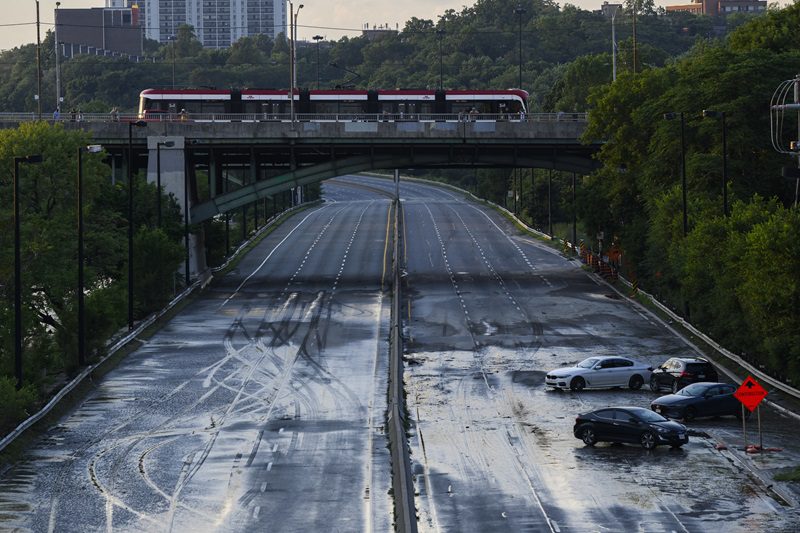How reinsurance rates are squeezing primary insurers

With more intense extreme weather events in Canada and around the world, the affordability and availability of global reinsurance is not a given as perhaps it was in the past, an Aviva Canada executive said earlier this month at the RIMS Canada Conference in Vancouver.
Four large catastrophes this summer cost Canadian property and casualty insurers $7.1 billion — $2.8 billion from the Calgary hailstorm, $2.5 billion from flooding in Quebec, $940 million from Toronto’s July flooding and $880 million from the Jasper, Alta. wildfire. Combined with other Cats throughout the year, insurers are expected to pay out more than $7.7 billion in damages already in 2024, with more than two months left in the year.
Reinsurance is expected to cover about half of the cost of the four summer Cats, Peter Askew, president and CEO at reinsurance broker Guy Carpenter (Canada), said during the National Insurance Conference of Canada in September.
During the Oct. 6 to 9 RIMS Canada Conference, Shaun Walsh, Aviva Canada’s vice president of property and reinsurance, commercial insurance, pointed to the historical rate on line (ROL) that reinsurers have charged in the global Cat market.
“In the last few years, it’s starting to trend upwards,” he says of ROL during a session, Lessons Learned From Yesterday’s Emerging Risks. ROL is the division of the reinsurance premium by reinsurance limit; for example, a $10 million Cat cover with a premium of $2 million would have an ROL of 20%. Walsh describes ROL as essentially reinsurers’ cut when they provide Cat reinsurance.
“So, that pricing is going up; insurance companies’ net retentions are going up,” he says. “That’s going to have consequential effects on insurers’ attitudes, where they offer catastrophic hazard protection and what they charge for it, and what [their deductible is] for it.
“So, I would say just that right now, we look at other areas of risk transfer, and we look at how to manage our net retention — that’s our deductible as an insurance company — but the affordability and availability of global reinsurance is not a given as perhaps it was in the past.”
Geolocations vs. postal codes
For better risk assessment, the exact geographical location of a property is important, Walsh adds. Geolocations are much more precise than postal codes, which are large in Canada and can contain many hazards.
“[Postal] codes are for postal workers,” he says. “We need to focus on the longitude, latitude, or at least the precise geographical location of a property to understand what it’s exposed to.
“And then we need to understand the level of hazard that can impact us from a natural, catastrophic perspective, and not only based on today’s hazard level, but on future hazard levels that climate change is going to bring us in 2030, 2040, 2050 and beyond.”
Looking at the Toronto flooding and Jasper wildfire, the industry also learned that pre-existing environmental conditions are important.
Prior to the Ontario floods, there were three weeks of sustained daily rainfall, which saturated the soil. “So then when we had a massive, intense burst of rainfall, we had significant loss.”
Three weeks before the Jasper event, the temperature was extremely hot, Walsh adds.
“The other thing we learned from Jasper is that it’s not the wall of fire that destroys properties — it’s the embers and the smoke that causes the insured damage,” he says. “If it’s the embers, which can travel up to…five kilometres possibly, and it’s the smoke, that means mitigation can help reduce a wildfire loss.”
During another conference session, a speaker said structures are particularly susceptible to ember ignition due to openings in buildings. Manually closing these openings is an option, as are ember-proof vent covers.
A “partial solution” could even be a 1/16-inch stainless steel screen, says Andrew Foote, senior consultant and wildland fire and natural hazards analysis lead with Sigma7 Paragon Risk Engineering.
Feature image: The Insurance Bureau of Canada estimates over seven billion dollars in insured losses following four catastrophic weather events this summer. Cars remain stranded on the Don Valley Parkway as water recedes following heavy rain that caused flooding in Toronto on Tuesday, July 16, 2024. THE CANADIAN PRESS/Christopher Katsarov



